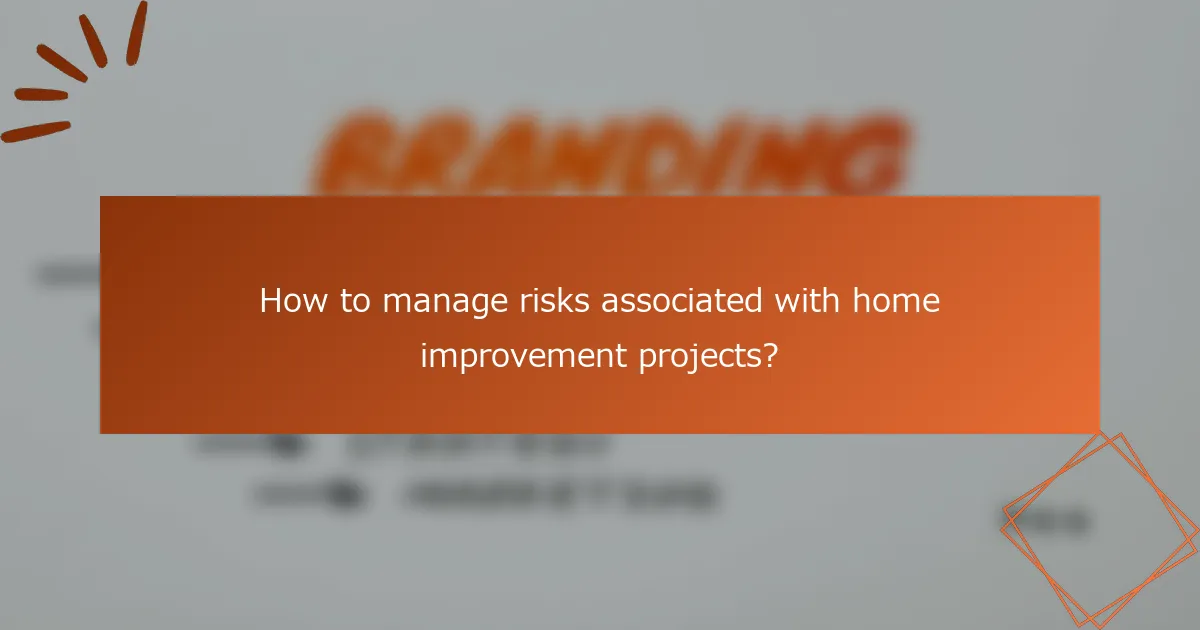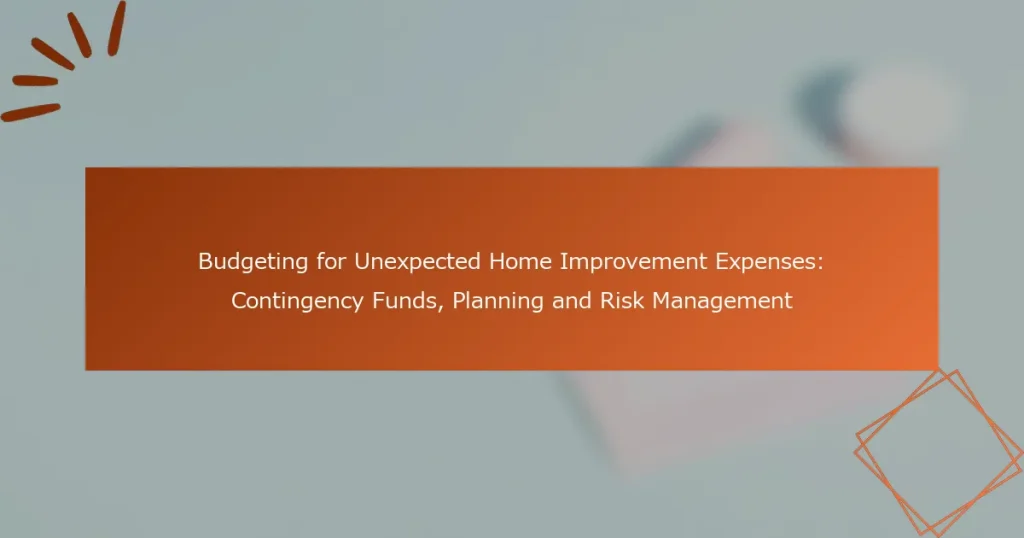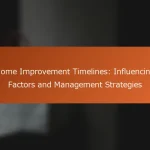日本では、予期しない住宅改善費用がさまざまな問題から発生することがあり、迅速な対応が求められます。屋根修理や配管問題、電気設備のアップグレード、基礎の問題、害虫駆除など、各々が独自の課題とコストを伴います。

Unexpected home improvement expenses in Japan: What are the common types?
In Japan, unexpected home improvement expenses can arise from various issues, often requiring immediate attention. Common types include roof repairs, plumbing issues, electrical upgrades, foundation problems, and pest control, each presenting unique challenges and costs.
Roof repairs
Roof repairs are a frequent unexpected expense, especially in regions prone to heavy rainfall or snow. Damage can occur due to weather conditions, aging materials, or poor installation, leading to leaks and structural issues.
When budgeting for roof repairs, consider the type of roofing material used, as costs can vary significantly. For instance, repairs for tile roofs may range from ¥10,000 to ¥50,000 per square meter, depending on the extent of the damage.
Plumbing issues
Plumbing issues can manifest as leaks, clogs, or pipe bursts, often requiring immediate repair to prevent water damage. Common causes include aging pipes, tree root intrusion, or improper installation.
When addressing plumbing problems, it’s wise to set aside a contingency fund of around ¥50,000 to ¥150,000 for emergency repairs. Regular maintenance can help mitigate these costs by identifying issues before they escalate.
Electrical upgrades
Electrical upgrades may become necessary due to outdated wiring or increased power demands from modern appliances. These upgrades can enhance safety and efficiency but often come with significant costs.
Budgeting for electrical work typically ranges from ¥30,000 to ¥100,000, depending on the complexity of the upgrade. It’s essential to hire a licensed electrician to ensure compliance with local regulations and safety standards.
Foundation problems
Foundation problems can lead to serious structural issues if not addressed promptly. Common signs include cracks in walls, uneven floors, or doors that stick, often caused by soil movement or water damage.
Repairing foundation issues can be costly, often ranging from ¥100,000 to ¥500,000 or more, depending on the severity. Regular inspections can help catch these problems early and reduce long-term expenses.
Pest control
Pest control is another unexpected expense that homeowners may face, especially in areas with high humidity or dense vegetation. Common pests include termites, rodents, and ants, which can cause significant damage if left untreated.
Budgeting for pest control services typically ranges from ¥10,000 to ¥50,000, depending on the type of pest and treatment required. Regular inspections and preventive measures can help minimize the risk of infestations and associated costs.

How to create a contingency fund for home improvements?
Creating a contingency fund for home improvements involves setting aside a portion of your budget specifically for unexpected expenses. This proactive approach helps ensure that you are financially prepared for any surprises during renovation or repair projects.
Determine a percentage of your budget
Start by deciding what percentage of your overall home improvement budget will be allocated to the contingency fund. A common recommendation is to set aside around 10-20% of your total budget. This range provides a buffer for unforeseen costs while still allowing for adequate funding of your primary projects.
For example, if your home improvement budget is $10,000, consider reserving $1,000 to $2,000 for unexpected expenses. This way, you can manage surprises without derailing your entire project.
Set up a separate savings account
To effectively manage your contingency fund, open a separate savings account dedicated solely to home improvement expenses. This separation helps you track your savings and prevents you from inadvertently spending the funds on non-related expenses.
Look for a savings account that offers a competitive interest rate but allows easy access to your funds when needed. This way, your money can grow while remaining available for emergencies.
Regularly contribute to the fund
Make it a habit to regularly contribute to your contingency fund, even if it’s a small amount each month. Consistent contributions can help you build your fund over time, ensuring that you have enough set aside when unexpected costs arise.
Consider automating your contributions by setting up a monthly transfer from your primary account to your dedicated savings account. This strategy simplifies the process and ensures that you are consistently saving for future home improvement needs.

What are the best planning strategies for home improvement budgets?
Effective planning strategies for home improvement budgets involve careful assessment of your property, prioritization of repairs, and thorough research of local contractors. By implementing these strategies, you can better manage unexpected expenses and ensure your budget remains intact.
Conduct a thorough home inspection
A comprehensive home inspection is crucial for identifying existing issues that may require immediate attention. This process typically includes checking the roof, plumbing, electrical systems, and foundation. Hiring a certified inspector can provide a detailed report, helping you understand the condition of your home.
During the inspection, take note of any potential problems that could lead to larger expenses later. For example, a small leak in the roof could escalate if not addressed promptly. Create a checklist of findings to prioritize repairs based on urgency and impact on your living conditions.
Prioritize necessary repairs
Once you’ve identified issues during the inspection, prioritize repairs based on safety and necessity. Focus on critical areas such as structural integrity, electrical systems, and plumbing before moving on to cosmetic improvements. This ensures that your home remains safe and functional.
Consider creating a tiered system for repairs: urgent, important, and optional. Urgent repairs should be addressed immediately, while important repairs can be scheduled for the near future. Optional improvements can be postponed until your budget allows for them.
Research local contractors
Finding reliable local contractors is essential for successful home improvement projects. Start by gathering recommendations from friends, family, or online reviews. Look for contractors who specialize in the type of work you need and have a solid reputation in your area.
Request multiple quotes to compare pricing and services. Ensure that each contractor is licensed and insured, and check their references to gauge their previous work quality. This research can help you avoid common pitfalls, such as hiring unqualified individuals or overspending on services.

How to manage risks associated with home improvement projects?
Managing risks in home improvement projects involves careful planning and proactive measures. By assessing potential issues and implementing strategies, homeowners can minimize unexpected costs and delays.
Obtain multiple quotes
Getting multiple quotes from contractors is essential for understanding the market rate for your project. Aim to gather at least three estimates to compare pricing and services offered. This practice not only helps in identifying a fair price but also allows you to gauge the professionalism of different contractors.
When reviewing quotes, look for detailed breakdowns of costs, including materials and labor. Be wary of significantly lower bids, as they may indicate subpar quality or hidden costs.
Check contractor credentials
Verifying contractor credentials is crucial to ensure you hire a qualified professional. Check for licenses, insurance, and any relevant certifications that demonstrate their expertise. In many regions, contractors are required to hold specific licenses to perform certain types of work.
Additionally, read reviews and ask for references from previous clients. This can provide insight into their reliability and quality of work, helping you make an informed decision.
Understand warranty options
Understanding warranty options is vital for protecting your investment in home improvements. Many contractors offer warranties on their workmanship, while manufacturers provide warranties on materials. Familiarize yourself with the terms and duration of these warranties to know what is covered and for how long.
When evaluating warranty options, consider what happens if issues arise after the project is completed. Ensure you have clear contact information for claims and understand the process for addressing any potential problems.

What are the local regulations for home improvements in Japan?
In Japan, local regulations for home improvements vary by municipality but generally include requirements for building permits and adherence to safety codes. Understanding these regulations is crucial to ensure compliance and avoid potential fines or project delays.
Building permits
In Japan, obtaining a building permit is often necessary for significant home improvements, such as structural changes or expansions. The application process typically involves submitting detailed plans to the local government, which may take several weeks to approve.
Homeowners should check with their local ward office or city hall to determine specific requirements, as these can differ significantly across regions. Failing to secure the appropriate permits can lead to costly fines or the need to undo completed work.
Safety codes
Safety codes in Japan are designed to ensure that home improvements meet structural integrity and safety standards. These codes cover aspects such as earthquake resistance, fire safety, and electrical installations, reflecting Japan’s unique environmental challenges.
When planning home improvements, homeowners should consult the latest safety regulations applicable in their area. Engaging a qualified contractor familiar with these codes can help navigate compliance and ensure that renovations are safe and legal.


